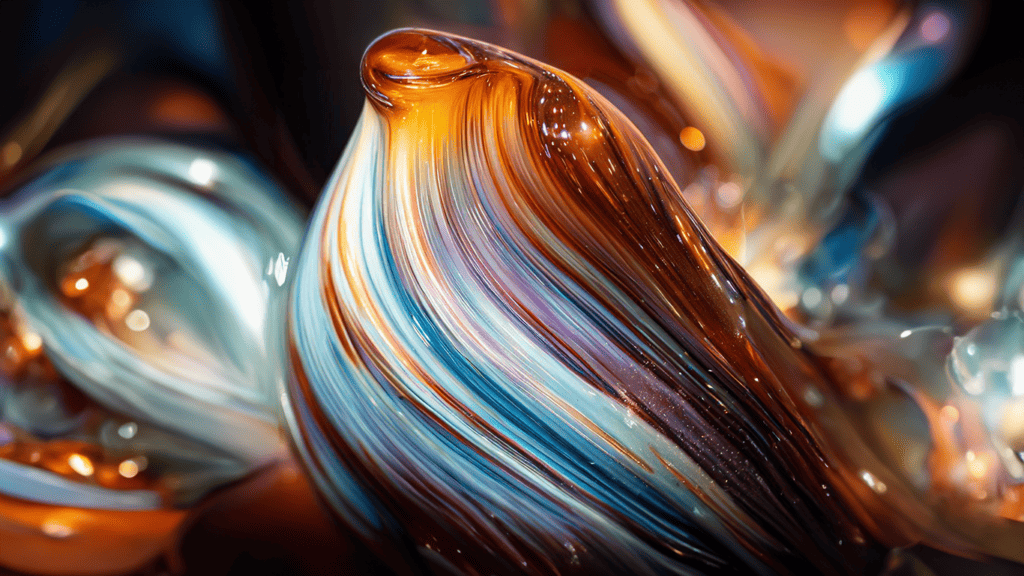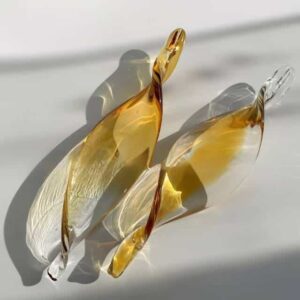From Molten Magic to Mesmerizing Art: The Journey of Hand-Blown Glass
Published on 2023年 8月 27日 by iartglass

Introduction
Hand-blown glass is more than just a medium; it’s a mesmerizing dance between fire, air, and human skill. This age-old craft, with its luminous allure, tells a story that stretches across millennia. As we traverse through the annals of history, we uncover civilizations that reveled in the beauty of this art, from holding the elixirs of life to standing as symbols of affluence and creativity.
It’s fascinating to note how a technique as ancient as hand-blown glass can find its space in contemporary homes, especially in the creations of Siga Art Glass, who blend tradition with modern aesthetics. Their pieces aren’t just objects; they’re a journey through time, mirroring the historical significance and evolution of this captivating art form.
Origins of Hand-Blown Glass
Long before the mesmerizing pieces of Siga Art Glass’s hand-blown lamps illuminated our spaces, the practice began with primitive yet profound purposes.

- Ancient Egyptians: The first known instances of hand-blown glass trace back to Ancient Egypt, around 1500 BC. These early artifacts were primarily used to store precious perfumes and medicinal oils. Their delicate craftsmanship stood as a testament to the importance of their contents.
- Roman Empire: By the time of the Roman Empire, the use of hand-blown glass expanded remarkably. From daily utility vessels to luxury goods, glass items found their way into the homes of both the commoners and the elite.
- Phoenicians: The Phoenician traders, known for their vast trade networks, played a crucial role in the spread of hand-blown glass techniques. Their decorative tokens became highly sought after, paving the way for the evolution of glass artistry in subsequent cultures.
The journey from these early uses to the artistic masterpieces of today is a testament to human innovation and the ever-evolving significance of hand-blown glass.
The Artistic Evolution
The transformation of hand-blown glass from a functional medium to an art form is a narrative of human creativity and its interplay with cultural influences. Over centuries, the allure of glass expanded beyond mere utility, positioning itself as a canvas for artisans to express and innovate.
Transition from Practical Use to Decorative Art
Historically, the functional aspects of hand-blown glass dominated its usage: from the simple storage of liquids to windows that allowed light while protecting from the elements. However, as civilizations advanced and trade expanded, so did the appetite for luxury and decorative items.
For instance, during the Renaissance, there was a significant resurgence of interest in hand-blown glass, with regions like Murano in Italy becoming renowned for their intricate chandeliers and decorative pieces. These objects were no longer just about function; they were symbols of status, wealth, and aesthetic sensibility.
Influence of Different Cultures on Designs and Techniques
Hand-blown glass became a canvas upon which cultures imprinted their unique identities:
- Middle Eastern Cultures: Known for intricate patterns and vivid colors, the Middle Eastern artisans developed techniques that emphasized detailed designs, setting the foundation for the modern artistic creations we witness today.
- Asian Influence: The Asian domain brought with it delicate forms and serene designs, many inspired by nature and traditional symbols. These designs often evoked a sense of harmony and balance.
- European Flair: Europe, with its rich history and artistic movements, infused its glass creations with everything from Gothic intricacy to the flowing forms of Art Nouveau.
Each culture not only contributed its distinctive design but also introduced innovative techniques, refining and evolving the craft of hand-blown glass over millennia.
The Process: An Intricate Dance of Craftsmanship
Diving into the world of hand-blown glass, one marvels at the incredible transformation from raw materials to breathtaking art. It’s not just a process; it’s a dance of precision, patience, and unparalleled skill.
The Raw Materials
At its core, glass blowing begins with three primary ingredients:
- Sand (Silica): The primary ingredient, acting as the backbone.
- Soda Ash: Reduces the melting point of the sand.
- Limestone: Adds durability to the final product.
By combining these in a furnace, the stage is set for the molten magic to come alive.
The Process of Turning Molten Glass into Intricate Designs
Starting with gathering the molten glass on a blowpipe, the glassblower begins the intricate process:
- Heating: The gathered glass is reheated to achieve a honey-like consistency.
- Shaping: Using tools like jacks, shears, and wooden paddles, the artisan shapes the glass, imprinting their vision onto the molten form.
- Blowing: Breath becomes an instrument, expanding the glass into hollow forms or intricate structures, much like the stunning hand-blown glass chandeliers of today.
- Cooling: Once the desired shape is achieved, the glass is cooled slowly to ensure durability and clarity.
The Role of a Glassblower and Their Tools
The glassblower, often seen as both an artist and a technician, possesses a profound understanding of the material and its behavior. Their tools, from the simple marver (a flat table for shaping) to the more complex optic molds, become extensions of their hands, allowing them to manipulate, sculpt, and bring their vision to life. Their contribution to pieces like the Siga Art Glass abstract gourd is a testament to the depth of skill and artistry involved in this age-old craft.
Siga Art Glass: Pioneering Modern Designs with Traditional Techniques
In a world where art often flirts with technology, Siga Art Glass stands as a beacon of tradition intertwined with modernity. With its foundation deeply rooted in the ancient craft of hand-blown glass, Siga has been able to chart its unique path, dazzling enthusiasts and collectors alike.
Introduction to Siga Art Glass
Siga Art Glass, with its commitment to craftsmanship and innovation, has become a household name for those seeking pieces that are more than just decorative objects – they’re stories, emotions, and reflections of a rich heritage. Born from a passion for preserving the ancient art of glassblowing, Siga has managed to carve a niche where art meets functionality.
Their Unique Approach to Hand-Blown Glass
While many modern studios have sought the assistance of machines and molds, Siga Art Glass remains faithful to the human touch. Their approach combines:
- Personal Artistry: Each piece is a testament to the glassblower’s vision, making every creation unique.
- Modern Aesthetics: While rooted in tradition, their designs resonate with contemporary tastes, whether it’s the mesmerizing swirls of a glass pendant globe light or the abstract elegance of other creations.
- Function with Form: Siga’s offerings aren’t just for show. They’re designed to be integral parts of a home, merging beauty with utility.
How They Maintain Traditional Craftsmanship in Modern Designs
Siga’s magic lies in its dedication to the old ways. They respect the process, understanding that true beauty in hand-blown glass comes from patience, skill, and, most importantly, human touch. By hosting workshops and encouraging hands-on learning, they keep the flame of traditional craftsmanship alive. Yet, when you look at pieces like the dark blue river wave chandelier, it’s evident that modern design principles are at play, creating a harmonious blend of the old and new.
The Wonders of Hand-Blown Glass in Contemporary Spaces
Modern interior design has found a beloved companion in hand-blown glass. Its allure, versatility, and the sheer range of designs make it an invaluable asset in contemporary spaces.
Hand-Blown Glass in Home Decor
From the living room centerpiece to the subtle additions in a study, hand-blown glass brings a touch of elegance wherever it resides. Be it vases that hold fresh blooms or abstract gourds that stand as art pieces, hand-blown glass elevates the aesthetics of any room.
Impact of Hand-Blown Glass Pieces in Interior Design
The impact is twofold:
- Visual Appeal: The luminous nature of glass captures and plays with light, creating dynamic visual effects in spaces.
- Emotional Resonance: Knowing that a piece is handcrafted adds a layer of depth and connection, making spaces feel more personalized and alive.
Unique Lighting Options and Their Transformative Power in Spaces
Lighting isn’t just about illuminating a room; it’s about creating moods, drawing focus, and enhancing design themes. Hand-blown glass lighting, such as the exquisite lamps from Siga, brings a transformative power:
- Ambience Creation: The soft glow through hand-blown glass creates a warm, inviting atmosphere.
- Artistic Statements: These aren’t mere light sources. They’re conversation starters, focal points, and declarations of style.
- Versatility: Whether it’s a minimalist space or a vintage-themed room, hand-blown glass lights seamlessly blend in, always adding, never overpowering.
Caring for Your Hand-Blown Glass Creations
Hand-blown glass, with its delicate curves and luminous charm, requires special care to ensure it retains its beauty and remains a cherished piece in your collection. Just as every piece is a result of painstaking craftsmanship, maintaining it too requires a gentle touch.
Tips for Cleaning and Maintaining their Shine and Integrity
- Gentle Cleaning: Always use a soft cloth, preferably microfiber, to avoid scratches. For dirt or stains, dampen the cloth slightly with lukewarm water.
- Avoid Harsh Chemicals: Commercial cleaners might contain chemicals that can harm the glass’s surface or alter its color. Instead, opt for a mild soap solution.
- Regular Dusting: Dust can accumulate and dull the sparkle of your glass piece. A regular light dusting keeps it shining bright.
- Safe Display: Keep your glass creations in areas with low traffic to avoid accidental bumps. Using a stable base or platform can prevent any tipping.
- Avoid Extreme Temperatures: Rapid temperature changes can cause cracks. If you’re lighting candles inside glass holders, ensure the glass is at room temperature.
Preserving their Beauty for Generations
For those who want their hand-blown pieces to become heirlooms, it’s about more than just regular cleaning. It’s about:
- Documentation: Keep a record of the piece’s origin, artist, and any specific care instructions. This not only maintains its value but also its history.
- Professional Restoration: In case of any damage, instead of DIY remedies, consult a professional to restore its original beauty.
- Safe Storage: If you’re keeping it away, wrap it in soft fabric and store in a padded box. Avoid stacking or overcrowding.
- Education: Teach younger family members about its significance and care. After all, preservation is as much about respect and understanding as it is about physical care.
Conclusion
The timeless allure of hand-blown glass is undeniable. Each shimmer, each curve, each play of light tells tales of ancient traditions, dedicated artisans, and the beauty of human expression. In a world increasingly veering towards the mass-produced, hand-blown glass stands as a testament to individual artistry.
At the heart of this beautiful journey is the invitation to explore – to look beyond the surface and see the years of tradition, the hours of labor, and the spirit of creativity. Whether it’s the ethereal glow of a Siga Art Glass lamp or the intricate designs of a centerpiece, there’s a story waiting to be discovered.
In every curve, in every glint, there’s artistry. And in that artistry, there’s a world waiting to be appreciated.




